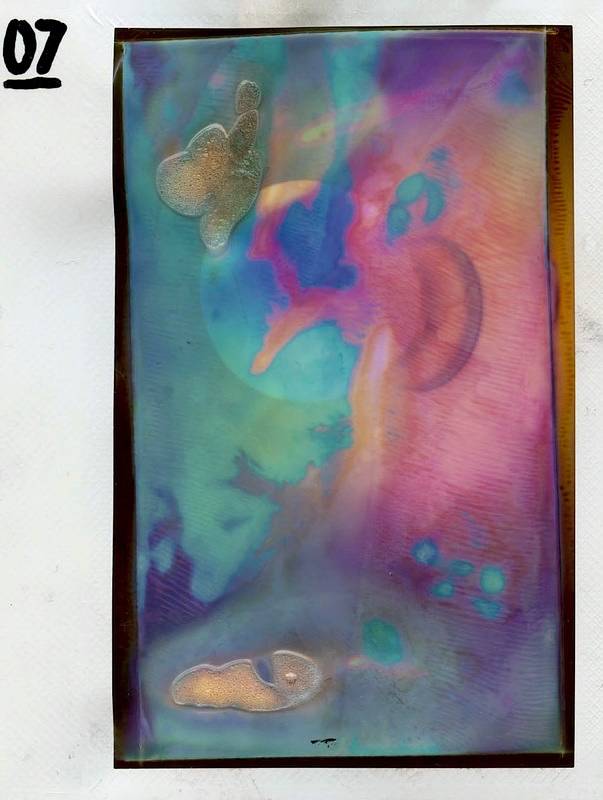Instax Film Manipulation with Bryson Chisholm
2 24 Share TweetHave you ever thought about burying your negatives? Or freeze your instax shots while they're processing? Well, thankfully Bryson Chisholm has and as absurd as it might sound, his little experiments result in mind-blowing little pieces of art. We chatted with the Canada-based artist about his methods and tips for instax film manipulation and what he loves about its trial and error process.
Welcome to the Lomography Magazine, Bryson. Please introduce yourself and your work to our community.
Hi! My name is Bryson Chisholm, I am an intermedia artist currently living in Halifax, Nova Scotia. I first started experimenting with instant film while at art school where I became interested in testing the limitations of the medium by manipulating the chemical properties of the film. Whether the images are burned, buried or soaked in a bath of cleaning products, the film undergoes physical changes that are beyond their original intention. It's really cool to see how things that degenerate the material can also work to obscure things like time, place and memory.
What sparked your interest in film photography and in particular in experimenting with instant film?
What attracted me to experimenting with instant film was that I could be in control of how the image turned out, and that it was completely devoid from the technical side of photography that was instilled in me. It was really liberating for things like exposure, framing, focus and depth of field to suddenly feel irrelevant to what I was doing.
Can you tell us a little bit about your process when it comes to manipulating instax film in particular?
With manipulating instant film you have to be quick and have all your tools on hand, because you only have 3 minutes to alter your photo before it is fully developed. I start by cutting a window inside of the frame on the backside of the photo. Then with cotton swabs, q-tips and other mark making objects I'll apply the chemicals/mediums that I've set out and try to create patterns and textures. Sometimes if i'm worried a chemical will create a color thats too saturated, i will freeze the photo before the chemical is fully set.
What's your favorite way of manipulating photos?
I can't say that I have a favorite way, it can be really spontaneous and I'm trying to achieve different results every time. What I enjoy most about manipulating images is how hands on it is. Whichever the techniques is; cutting, burning, freezing or applying chemicals, you tend to go about it really methodically. Knowing which chemicals produce certain colors, I go about it strategically with how and where I am applying them to a photo. This kind of makes it feel like painting to me, having all of these little tools for mark making and applying color.
Can you pick a favorite photo from your selection and tell us it's particular story?
This photo below stands out to me because it's really stripped down and detached of anything that you would identify a photograph as being. This was a photo I took of a plain white wall with no subject matter or composition, manipulated with different chemicals to create all the colors and patterns that appear. I was just really excited about how this photo turned out because it was purely coincidental and the color scheme that it produced was so different.

During your experiments, was there ever a moment that really stuck out to you? A particular surprise maybe?
The whole process is really just trial and error, and taking notes on how the film reacts to the elements you are exposing it to. Although even with a script, it can be hard to mimc previous results because the film reacts so unpredictably. I think the most surprising result I had was when I was preventing photos from developing fully by freezing them midway. I figured out that if you exposed instant film to heat through various stages of freezing, you get a different shade of blue each time you try and burn it.
Anything that you haven't tried yet but you're curious to explore in the future?
I really want to experiment more with pretreating rolls of 35mm film. It's kind of dicey though, if you boil a roll of film in some chemicals and tell the person developing it what you did then chances are they're not going to want to develop it for you! The only method of 35mm film manipulating i've tried is burying negatives in compost. Mould and bacteria eventually eat away at the emulsion and distorts the image. After you let it do it's thing for a week or so, you can scan the negatives and see the degeneration and how it's affected color and texture.
Do you have any advice for our community in case someone wants to dip their toes into chemical film manipulation? (not literally, of course)
I definitely want to stress the importance of safety when manipulating film. With instant film, you're literally carving open the back of the photo and exposing yourself to the ink and chemicals that are enclosed, and often adding more chemicals to create reactions. I always wear latex gloves, work outdoors and/or wear a respirator. Other than that just have fun with it, and don't be concerned with making mistakes or trying to anticipate the results. I know some people view film as being a precious material, but when manipulating images you have to accept that you're gonna burn through a ton of film and destroy a lot of in the process before you finally find the results that you want.
Check out Bryson's website for more of his work.
written by birgitbuchart on 2019-06-30 #gear #tutorials #instant #instax #experiment #manipulation #film-manipulation





























2 Comments